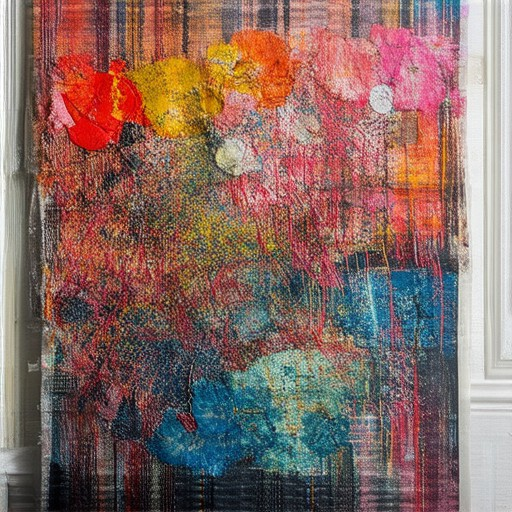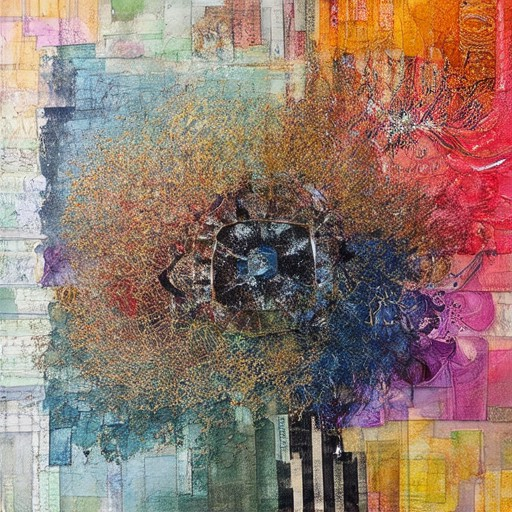Mixed media art has emerged as a dynamic and versatile way for artists to express themselves, blending diverse materials and techniques to create unique works of art. Whether you’re a seasoned artist or just beginning, exploring mixed media can transform your creative process and open up endless possibilities for self-expression. From combining paint, ink, and collage elements to experimenting with digital tools, mixed media offers a flexible medium for artists to push boundaries and craft one-of-a-kind pieces. In this comprehensive guide, we’ll walk you through the essential steps to create stunning mixed media collages, providing practical tips, inspiring ideas, and expert advice to help you master this versatile art form. Whether you’re looking to add depth to your paintings, experiment with new textures, or simply explore a fresh creative outlet, this tutorial is designed to inspire and empower you to create mixed media masterpieces that truly stand out.

How to Start Mixed Media Art
To embark on mixed media art, follow these organized steps:
- Gather Your Supplies: Begin by collecting materials such as old magazines, markers, glue sticks, fabric scraps, a sketchbook, and pencils.
- Choose a Theme: Select a central theme, like “Nature,” to guide your creativity and keep your project focused.
- Experiment with Media Combination: Decide how to integrate different mediums into your piece. Consider using paint for the background, stamps for textures, and fabric for added depth.
- Layer Thoughtfully: Start with the canvas or paper as your base. Gradually add paint, then incorporate other materials like fabric or tissue paper. Consider starting with the strongest element or the most delicate part depending on your preference.
- Combine Textures Carefully: Test each texture separately on a small scale before applying them together to avoid a messy appearance. Observe how they interact and adjust as needed.
- Use Appropriate Tools: Experiment with tools like brushes, sponges, or even your fingers to see which work best with your chosen mediums. Start with a simple brush for paint application.
- Work Step-by-Step: Pay attention to timing to avoid unwanted reactions between materials. Let each medium cure or set before moving on to the next.
- Stay Focused on the Theme: While allowing for spontaneous inspiration, dedicate your main piece to the chosen theme. Set aside a small area for experimental touches if ideas strike.
- Consider Final Display: Once completed, decide how to frame or display your artwork. Fabric pieces may be hung as tapestries, while others might benefit from protective casing.
- Document and Reflect: Keep a journal of your process and take photos to track your progress and share your journey online if desired.
- Clean Up Thoughtfully: Use solvents for marker cleanup and wash hands after handling glue to maintain a tidy workspace and prevent overwhelming messes.
What Are the 6 Major Types of Mixed Media?
Mixed media art combines diverse materials, techniques, and elements to create unique and innovative works. Below are the six primary types of mixed media art, each offering a distinct approach to artistic expression:
- Collage : This type involves assembling found objects, photographs, paint, and/or textures onto a surface to create a layered effect. Collages often explore themes of recycling, texture, and composition.
- Assemblage : Similar to collage, assemblage focuses on grouping unrelated objects to form a cohesive piece. However, assemblage pieces often emphasize three-dimensional elements and storytelling.
- Sculpture : Mixed media sculptures combine materials like clay, metal, wood, and resin to create three-dimensional forms. These works often challenge traditional sculpture norms by incorporating unexpected elements.
- Installation Art : Installation art uses space and environment to convey messages. Artists may alter existing spaces or create temporary structures filled with multimedia elements to engage the viewer.
- Altered Book Art : This type transforms books into canvas-like surfaces through cutting, folding, and painting. Altered book art allows for personal storytelling and artistic experimentation.
- Wet-and-Dry Media : Combining wet and dry media creates interesting textures and contrasts. Water-based paints, inks, and gels interact with oil-based or acrylic mediums to produce dynamic effects.
Mixed media art provides endless possibilities for creativity, allowing artists to push boundaries and experiment with texture, color, and form. Whether you’re working on a large-scale installation or a small-scale collage, these techniques offer a rich medium for self-expression and artistic exploration.

Rules for Mixed Media Art
Mixed media art is a versatile and dynamic form of artistic expression that combines diverse materials and techniques to create unique works. While there are no strict rules, understanding some key principles can help you create compelling pieces. Here’s a breakdown of essential guidelines:
- Define Your Medium: Decide which materials you’ll use. Common options include paint, ink, collage elements, metal, glass, fabric, or even digital tools.
- Layer Thoughtfully: Start with a base material and build layers on top. Each layer adds depth and texture, so plan your order carefully.
- Consider Texture and Dimension: Use textures like sandpaper, fabric, or metal to add contrast. Incorporate three-dimensional elements for depth.
- Blend Materials Smoothly: When mixing materials, ensure they blend well. Use glue, paste, or paint to secure elements and create seamless transitions.
- Experiment with Color and Contrast: Don’t hesitate to mix bold colors or unexpected contrasts. This creates visual interest and adds character to your work.
- Be Mindful of Medium Consistency: Maintain consistent thickness and application to prevent unevenness. This is crucial when working with paints or adhesives.
- Plan for Layering Order: Decide the sequence of layers to achieve your desired effect. Start with lighter elements and finish with darker ones to avoid smudging.
- Balance Composition: Arrange elements thoughtfully to create balance. Consider symmetry, asymmetry, or a dynamic composition based on your vision.
- Document Progress: Take photos or notes as you work to track your progress and experiment with different combinations.
Remember, mixed media art is about creativity and personal expression. There are no strict rules—just guidelines to help you explore and refine your technique. With practice, you’ll develop your own unique style and approach to this fascinating art form.

Mixed Media Technique Explained
Mixed media art is a creative process that combines diverse materials and techniques to create unique artwork. This method allows artists to explore a variety of textures, colors, and styles within a single piece.
Components of Mixed Media
- Paints (oil, acrylic, water-based)
- Collage materials (paper, fabric, cardboard)
- Sculpture elements (foam, clay, metal)
- Textures (sand, wood, leather)
- Prints and stencils
Why Mixed Media is Valuable
Mixed media provides artists with the freedom to experiment and innovate. By blending different media, artworks become more dynamic and visually engaging. This technique also allows for layering and manipulation, enabling artists to create depth and dimension.
Examples of Mixed Media Art
Some popular forms of mixed media art include:
- Texured paintings combining oil paint with sand or glass
- Mixed-media collages incorporating fabric, paper, and found objects
- Three-dimensional works that merge sculpture with painted surfaces
- Photomontage pieces that blend photography with hand-painted details
Getting Started with Mixed Media
For those new to mixed media, consider the following tips:
- Start small: Experiment with a few materials before diving in
- Layer materials gradually to control the outcome
- Don’t fear failure—embrace the unexpected
- Consider the texture and weight of each medium
The Versatility of Mixed Media
Mixed media art is accessible to artists of all levels and styles. Whether you’re working in a studio or creating projects at home, this versatile technique offers endless possibilities for innovation and self-expression.
Explore mixed media art today and discover the unique perspectives it can bring to your creative practice!
What Happens If You Mix Acrylic and Watercolor Paint?
Mixing acrylic and watercolor paints can lead to unexpected interactions, affecting both the appearance and longevity of your artwork. Here’s a breakdown of what happens:
- Thickening Effect:** When mixed in equal parts, acrylic and watercolor can create a thicker medium, altering the consistency of your paint. This may make it easier to create textured effects but can also affect how the paint adheres to your surface.
- Waterproofing Issue:** Once dried, the mixture becomes waterproof. If you apply watercolor over acrylic, the watercolor may not adhere well due to the waterproof layer created by the acrylic. This can lead to peeling or cracking over time.
- Drying Time Interaction:** Acrylics dry quickly, often before watercolor paints. Applying watercolor on top of dried acrylic can result in poor adhesion, leading to a weak bond between the two mediums and an uneven finish.
- Color Enhancement:** The vibrant colors of acrylic can enhance the pigments in watercolor, potentially increasing the intensity of your hues. However, this effect may vary depending on the amounts used and the surface you’re working on.
- Surface Absorption:** The interaction between the two media can also depend on the type of surface you’re using. Acrylics are more durable on non-absorbent surfaces, while watercolors may bleed or spread more on absorbent materials like paper.
- Longevity Concerns:** The combination may lead to discoloration over time, particularly if exposed to light or harsh environments. This can cause the artwork to yellow or fade, reducing its longevity.
For optimal results, it’s generally recommended to use these mediums separately. Acrylics are ideal for bold, vibrant applications, while watercolors offer flexibility and a softer aesthetic. Experimenting with small batches can help you find the best approach for your project.

What’s the Difference Between Mixed Media and Collage?
Mixed media and collage are two distinct artistic techniques that share common ground but differ significantly in approach and execution. Below is a breakdown of their key characteristics and differences.
Mixed Media
Mixed media art involves the combination of various materials and substances to create a cohesive piece. These materials may include:
- Paints (oil, acrylic, water-based)
- Markers and ink
- Glue, tape, and adhesives
- Fabric, metal, glass, or other textured elements
- Photographs, cut-outs, or printed images
The focus in mixed media is often on texture, layering, and the interplay of different materials. Artists experiment with how these elements interact, creating unique surfaces and depths in their work.
Collage
Collage is a technique that involves assembling found objects, photographs, or cut-out shapes to form a composition. The key elements of collage include:
- Found objects (e.g., newspaper clippings, fabric scraps, buttons)
- Photographic prints or scanned images
- Paper-cut shapes
- Paint or ink for adding color and detail
Collage emphasizes the arrangement of these elements to create a visually interesting and often narrative-driven artwork. The process can be more deliberate and structured compared to mixed media.
Differences Between Mixed Media and Collage
While both techniques involve the use of multiple materials, they differ in their approach and intent:
- Materials: Mixed media focuses on a variety of substances like paints and textures, while collage primarily uses paper-based or three-dimensional elements.
- Process: Mixed media is often more experimental and layered, whereas collage tends to be more precise and structured.
- Outcome: Mixed media works often emphasize texture and surface manipulation, whereas collages usually highlight composition and arrangement.
Conclusion
Both mixed media and collage offer unique ways to express creativity and explore artistic ideas. Whether you prefer the experimental nature of mixed media or the structured approach of collage, both techniques can lead to stunning and meaningful artwork. Try experimenting with both to see how they can complement each other in your projects!




0 Comments